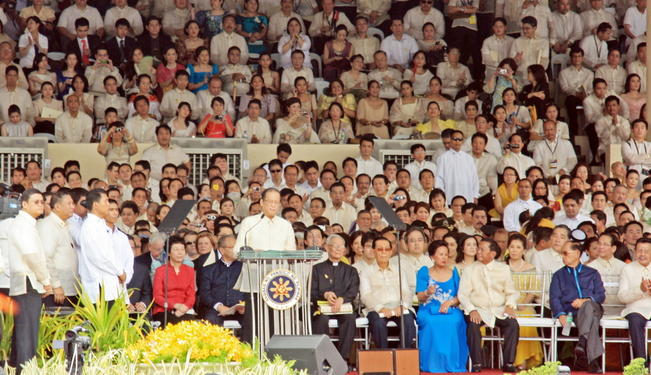Aquino is under pressure to improve socioeconomic conditions in the Philippines.
As President Benigno Aquino III, also known as “Noynoy” and “PNoy,” approaches the midpoint of his presidency, many question his domestic and foreign policy. Has Aquino, the son of progressive and renowned political figures, lived up to expectations?
A Bright Start
Benigno Aquino III was born with the pedigree for a memorable political run, at least as far as Philippine political dynasties go. As the son of political dissident Benigno “Ninoy” Aquino and his wife, Corazon “Cory” Aquino, the figurehead of the People Power Revolution, PNoy was primed with the tools to build upon a political dynasty. As a member of the Philippines’ Liberal Party, he rode the popularity wave stemming from the recent death of his mother to secure the 2010 presidential election.
In 2010, the Philippines was experiencing some of the ill-effects of the Global Financial Crisis — unemployment remained high and the devaluation of the Peso was a major concern. China flexed its muscles in disputed areas of the South China Sea and the education system required a major overhaul. Worse still, the Philippines had been unable to alter its reputation as a state that runs on patronage politics, and one that lags in achievement of the Millennium Development Goals.
While the new president did inherit a host of problems, many Filipinos had high expectations for PNoy. Following in the footsteps of both Ninoy and Cory Aquino, he was also championed as a politician dedicated to achieving transparency and political justice, especially in tackling the alleged corruption cases of previous administrations.
Thus far, PNoy has received mixed reviews from critics on his performance as the 15th President of the Philippines. There are people in various camps who think of him as a figurehead, and that his true usefulness rests in his political heritage and name; his ascension to the presidency was thought to be good for the Philippines in terms of its international reputation and relations.
On the other hand, the opposition and his critics slam him as an ineffective leader whose policies are as superficial as his “Walang Wang-Wang” or banning of special sirens and motorcades for politicians. Skeptics question the president's alleged successes as byproducts of past policies and bills passed under former administrations.
Indeed, the results of PNoy’s policies remain underwhelming and the Philippines continues to mire in political and economic mediocrity, despite displaying glimpses of political reform and of incredible growth potential. However, PNoy could still reallocate resources and refocus his efforts on the issues that do matter, and establish his administration as more than just the wang-wang and the “I hate the Arroyo administration” tirade.
The Wang-Wang President
President Aquino’s State of the Nation Addresses (SONA) have continued to appeal to many Filipinos by delivering the good news and work of his administration. It is no secret that Filipinos love to hear the good news that PNoy gives them. Filipinos at home and abroad are ecstatic at reports that the nation is progressing and moving forward in terms of its economic and political development.
However, the facts are not so optimistic; despite these proud SONA statements, many Filipinos remain below the poverty line and the Philippine Human Development Index (HDI) is stuck at a paltry 0.654 — a figure below the world and Asia Pacific HDI average.
PNoy’s early presidency has come to be defined as wang-wang: the Filipino metaphor for the siren used by politicians to carve routes in the heavy Philippine traffic, and which was incidentally one of the more commonly used words in PNoy’s second SONA in July 2012.
For PNoy, the removal of this entitlement and the pursued charges of the corrupt Arroyo administration represent symbols of great change in the collective Filipino attitude.
However, these decrees are ineffective for the most part. Doing away with wang-wang does nothing to abate government corruption in the form of institutionalized kickbacks, including the controversial Priority Development Assistance Fund (PDAF), to numerous public servants. Wang-wang, contrary to some popular belief, does little to alleviate the deplorable traffic situation in the Philippines; and politicians with their imposing motorcades and massive Fords will always find ways to push out other motorists.
It is quite unfortunate that this decree and the “Truth Commission” — the latter was created to investigate the corrupt dealings of the Arroyo administration and was later deemed unconstitutional — which were originally thought to be a hallmark of the president's noble anti-corruption campaign, are what the Aquino government stand for in many Filipino minds.
Needless to say, PNoy needs to focus on the long-term and redistribute his political and governmental resources to solve more pressing problems, setting a strong political and economic precedent for future Philippine generations. Wang-wang and the Truth Commission are, at best, well-intentioned messages with poor foresight and appurtenance.
It is common knowledge among Filipinos that the Arroyo administration swindled and deceived the public; the president's SONAs have strengthened that idea by contrasting the deficiencies of the previous administration with his own government’s impeccable performance. Granted, the Arroyo administration propagated and embodied the systemic corruption that exists in the Philippine political system. But focusing alone on these aspects of the administration takes away from the fact that Arroyo’s prudent economic policies laid the groundwork for a more stable economy, enabling the Philippines to cope with the Global Financial Crisis.
From an economic standpoint, it cannot be denied that the Philippines has the potential to sustain economic growth. Within the last three years, credit rating agencies such as Standard and Poor’s, Moody’s, Fitch, and Japan Credit Rating Agency have upgraded the international credit standing of the Philippines.
Further evidence of the Philippines’ economic and financial advancement can be seen in the increased balance of payment at the end of April, which was up by 55.4 percent to $1.809 billion from the same four-month period last year. The dollar surplus in April was close to $274 million, a strong reversal of last year’s $79 million deficit.
However, with this newfound wealth for the Philippines, it remains to be seen whether PNoy, rather than relying on the hype of these achievements as proof of his administration’s effectiveness, can sustain the Philippines’ economic development and prevent many of these surpluses from falling into corrupt officials’ hands. These credit ratings are positive signs for the Philippines, as it seeks credit and foreign funding to build economic infrastructure. The successes, however, must materialize themselves in the form of food and jobs for the working-class.
The assessment of PNoy's economic performance lies in the realm of unemployment and domestic consumption. The Philippines has stuck to its moniker as a site for multinational call-center operations and Business Process Outsourcing (BPO) — a trend that points to a floundering domestic economy and a somewhat homogenous job market that promises little for the new generation of Filipino job seekers. The dependence on relatively inconsistent Foreign Direct Investment (FDI), domestic employment from multinationals, and remittances (as a significant portion of GDP) is a lingering weakness of the Philippine economy. As of 2008, Overseas Foreign Workers’ (OFWs) remittances still account for 12 percent of GDP.
Domestic consumption has experienced very modest — but hopeful — increases. According to the Philippine National Statistical Coordination Board (NSCB), the Household Final Consumption Expenditure (HFCE) increased to 6.9 percent in the fourth quarter of 2012 from 6.4 percent in the same period last year.
PNoy could solidify and further stimulate the domestic economy moving forward, especially bringing the focus to the least contributors of the HFCE such as clothing and footwear, education, and recreation and culture.
Economy, Education, and Unemployment
An anti-corruption platform will do little to fix the long-term economic problems, especially unemployment. Economist Winnie Monsod and the Ibon Foundation's chief researcher, Sonny Africa, criticized PNoy for taking figures out of context since any new jobs created “were more than offset” by a growing labor force of 1.2 million people and an increase in underemployment, signifying a lack of better work opportunities.
This outlook does not bode well for many Filipino families, who will be forced to seek opportunities outside of the Philippines or remain in relative poverty. Queues at the Philippine Overseas Employment Administration (POEA) office are telling signs that there are more Filipinos seeking jobs overseas, despite PNoy’s statements about increased demand in the domestic labor market and the accompanying declaration that there are less Filipinos leaving the country for work opportunities.
This fact, together with an 829,000 increase in underemployment, indicate a rise in the number of low-quality work opportunities. Under PNoy, the number of unemployed and underemployed has increased from 10.9 million in 2010 to 11.7 million in 2012. This expansion stands in stark contrast to the widening gap of income inequality, represented by increases in the "net worth of the 40 richest Filipinos from $23 billion to $47 billion" in the same period.
There is much criticism on the Aquino administration for its failure to provide livelihoods for a nation where 35 percent of the population is under the age of 14. Indeed, employment prospects for young people remain bleak. According to Dylan Hamada, child labor and a lack of emphasis on education are major problems as 50 percent of children aged 11 to 15 are out of school, with many working in dangerous conditions to support their families. Although PNoy’s K to 12 education reform was viewed as a plan to help Filipinos compete in the global labor market, the extension of two years for the current primary and secondary public school systems is affecting the budget, namely due to a lack of funding and investment. Classroom overcrowding and a shortage of teachers, many of whom typically leave for better paying jobs abroad, have posed immense challenges.
In contrast to PNoy’s sweeping statements and high social ratings, approximately 4,500 Filipinos join the global diaspora every day to send remittances home to their families. Around 30 to 40 percent of Filipinos "rely on remittances" just to survive in the difficult conditions in the Philippines. According to Hamada, "one-third of the population lives on less than $1.25 per day" and high — and ever increasing — prices of fuel, food, and tuition fees remain heavy burdens to the average Filipino family.
The minimum wage in the National Capital Region is at a mere P466, or roughly $10, which is not enough to satisfy the actual cost of living for the average family of six, estimated at P1,008 — 54 percent more than what minimum wage laborers earn.
These conditions have been staples of previous administrations, so this information is not new to PNoy. It is worrying, however, that these numbers have not fluctuated to the positive side of the income spectrum since the passing of the decade, which could suggest profiteering by large companies and poor cost and labor regulations by government agencies. Data from the National Statistical Coordination Board indicates that 27.9 percent of the population fell below the poverty line in the first semester of 2012, which represents a one percent increase since 2009. Though this figure is lower compared to the 33.1 percent population under the poverty line in 1991, it is not a major drop. The slow percentage decrease could mean that many of the same problems which plagued previous administrations have not yet been adequately resolved and, unfortunately, remain pressing issues unaddressed or improperly handled by PNoy’s administration.
*[Read the final part here.]
The views expressed in this article are the author's own and do not necessarily reflect Fair Observer’s editorial policy.
Image: Copyright © Shutterstock. All Rights Reserved
Support Fair Observer
We rely on your support for our independence, diversity and quality.
For more than 10 years, Fair Observer has been free, fair and independent. No billionaire owns us, no advertisers control us. We are a reader-supported nonprofit. Unlike many other publications, we keep our content free for readers regardless of where they live or whether they can afford to pay. We have no paywalls and no ads.
In the post-truth era of fake news, echo chambers and filter bubbles, we publish a plurality of perspectives from around the world. Anyone can publish with us, but everyone goes through a rigorous editorial process. So, you get fact-checked, well-reasoned content instead of noise.
We publish 2,500+ voices from 90+ countries. We also conduct education and training programs
on subjects ranging from digital media and journalism to writing and critical thinking. This
doesn’t come cheap. Servers, editors, trainers and web developers cost
money.
Please consider supporting us on a regular basis as a recurring donor or a
sustaining member.
Will you support FO’s journalism?
We rely on your support for our independence, diversity and quality.







Comment